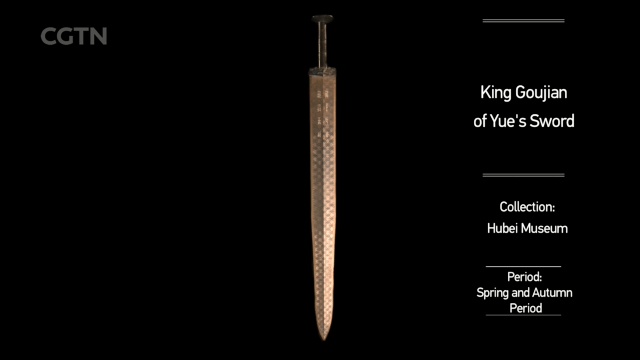
10:55, 30-May-2018
If Treasures Could Talk: What story would the Yue King Goujian's sword reveal?
05:33

We continue with our series "If Treasures Could Talk", showcasing some of China's most valuable ancient treasures. Today's masterpiece is from the Hubei Museum's collection. It's the Yue King Goujian's sword. The sword is an archaeological artifact of the Spring and Autumn period. It was discovered in 1965 in Hubei. Forged of copper and tin, it is renowned for its unusual sharpness and resistance to tarnish rarely seen in artifacts so old. Let's find out what story the ancient treasure could tell.
Two swords, one representing victory, the other, defeat. The first belonged to King Goujian of Yue. The second to his nemesis, King Fuchai of Wu.
Swords are called the king of blades. A spear strikes from a distance, knives slash and flail at random. Sticks merely serve to strike the weak. But a great swordsman, with his blade in hand, watches, waits, and then strikes when the moment is right. Fighting only the strong. Never harassing the weak. Always prevailing. These are the qualities of a fine sword and of a true knight.
The Han dynasty produced tales of many famous swordsmen. There was Yu Rang, the righteous avenger; Zhuan Zhu, the lonely hero; Ji Zha, famous for always keeping his word; and Jing Ke, the failed assassin. All true knights, they never attacked the weak, and when they drew their swords, even mighty lords trembled with fear.
But let's return to the fight between Goujian and Fuchai. The story begins with King Fuchai of Wu attacking the State of Yue, seeking to avenge his father, who had been killed by Yue's king, Goujian. Fuchai was victorious, but Goujian escaped and went into hiding in the Kuaiji Mountains, where he earned his keep as a lowly stable boy.
After three years, Goujian was pardoned by Fuchai. To remind himself of his humiliation, Goujian continued to live in a humble cottage. He even had a bladder suspended above his bed, from which he periodically drank gall. Finally, an opportunity presented itself. While Fuchai was campaigning in the north, Goujian attacked Wu.
Below the walls of his capital, Gusu, Fuchai was finally defeated and committed suicide. The victorious king had earned the right to own the finest of blades. The blacksmith obtained the best materials, and carefully polished every surface.
Tin was used to create a diamond pattern, while the hilt was inlaid with turquoise. Eleven concentric circles were carved into the base of the hilt, with an accuracy that would defy most craftsmen today.
Goujian occupied the State of Wu and became the last of the five hegemons – or great kings – of the Spring and Autumn Period. As such, he had achieved all his ambitions as conqueror and ruler. With thousands of soldiers chanting his name and his enemies slaughtered, he must have desired a sword suited to his elevated status.

SITEMAP
Copyright © 2018 CGTN. Beijing ICP prepared NO.16065310-3
Copyright © 2018 CGTN. Beijing ICP prepared NO.16065310-3